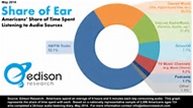 ≡
≡
How to Get A "Piece Of Mind"
Nov 14, 2023 by Sean Luce At a recent seminar, a sales associate at a radio station in Hagerstown, MD, asked me to provide some information on the concepts of "share of voice" and "share of mind."
At a recent seminar, a sales associate at a radio station in Hagerstown, MD, asked me to provide some information on the concepts of "share of voice" and "share of mind."
Consider this: two dogs are howling. Fido has a pitch that is tolerable yet annoying, and he barks with a frequency of two woofs per second. Rufus barks louder, is very annoying and has three woofs per second. Each dog barks for 30 minutes. As there are only two dogs barking, there are only two dogs vying for barking dominance. If they bark for exactly the same duration, then Rufus has the larger "share of voice."
SHARE OF VOICE - According to Richard Weiner, of Webster's New World of Media and Communications (1990), "share of voice is a brand's percentage of its advertising in relation to the total advertising in its category." If a person who shovels snow is advertising, and no other snow shoveler is advertising on any medium (not just radio) in that market, then the snow-shovel guy has a 100-percent share of voice in that market. Share of voice can be calculated for the marketplace as a whole or for a single medium; this is where you get into media dominance.
It's possible for an advertiser to have a 100- percent share of voice on a particular station, yet they still advertise in the newspaper - if you are calculating SOV only for your station. Unless you get the exact frequency of the ads in the newspaper and the reach, however, it's pretty tough to decipher the exact share of voice in the marketplace for this advertiser. It's always preferable to work with a local advertiser to whom you can guarantee a 100-percent share of voice on your station(s) because nobody else is advertising in that category (such as homebuilders).
Now, a greater share of voice doesn't necessarily mean that an advertiser running 20 ads per week has a bigger share of voice than the next advertiser, who is running 10 ads per week. Depending on the demo and daypart that you are measuring, you still would have to figure a reach-and-frequency schedule to determine who has greater share of voice, because it would come down to the advertiser who has more frequency in that demo and daypart relative to that category of business.
SHARE OF MIND - Again, Webster's says share of mind is "the percentage of all brand awareness or brand-advertising awareness in a category of product or service, usually elicited on an unaided basis."
The average consumer encounters thousands of advertising impressions per day - the exact
number is not known. Share of mind again goes back to the category you're talking about and the number of advertisers in the universe. (This is the same as your radio station's AQH rating, and it is measured by a factor of the total population.)
Let's say the average consumer is deluged with 2,000 advertising impressions daily in a specific market. If Burt's Burgers is running 10 ads per day and Bill's Burgers is running five ads per day (same category), then Burt has a 0.005 percent SOM that day vs. Bill, who has a 0.0025 percent SOM that day. Essentially, Burt has a bigger share of mind over Bill, if the audience is exposed to the exact same advertising impressions or at least is exposed to the same frequency. (Now you see where advertising week-in and week-out, 52 weeks a year comes in play.) This does not take into consideration any outside advertiser who is battling for SOM in the national spectrum and is reaching the market via national medium (such as satellite radio or USA Today).
Does it matter that one ad is recalled better than another advertiser's ad, resulting in skewing the market's SOM for that consumer? Sure it does! Find this year's most recalled Super Bowl advertisement and see who won for total recall by percentage of surveyed audience. One advertiser who ran one ad but is recalled twice as much as an advertiser who ran three ads can still have a greater share of mind, since the recall of the ad was better (though this doesn't necessarily mean the ad moved more product).
Simply put: If your client is top-of-mind in the consumer's brain when they shop for that advertiser's product or service, that's the only piece of mind you need. How to get inside the consumer's head, of course, is another thing.
Related Categories> Publications > Radio Ink




